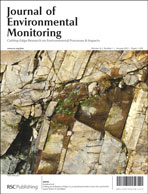Fifty-eight sediment samples were collected in 2009 from the bottom of river mouths near Kaohsiung Harbor (Taiwan) and the harbor channel for the analyses of polycyclic aromatic hydrocarbons (PAHs) using gas chromatography-mass spectrometry (GC-MS). Concentrations of total PAHs varied from 39 to 30 521 ng g−1 (dry weight); samples collected from the mouths of Love River, Canon River, Jen-Gen River, and Salt River showed the highest PAHs concentrations. This indicates that the major sources of sediment PAHs come from those polluted urban rivers and the harbor channel. In samples collected from the Salt River mouth, approximately 43% of the PAHs are identified as PAHs with 2 or 3 rings. However, samples collected from other locations contain predominantly PAHs with 4 rings (32 to 42%) or 5 and 6 rings (36 to 44%). Emissions from traffic-related sources and waste incineration contribute to the majority of PAHs found in most channel and river mouth sediments. However, coal/oil combustion is the main cause of high concentrations of PAHs observed in the Salt River mouth sediments. Principal component analyses with multivariate linear regression (PCA/MLR) have been used to further quantify the source contributions, and the results show that the contributions of coal/oil combustion, traffic-related and waste incineration are 37%, 33% and 30%, respectively.

You have access to this article
 Please wait while we load your content...
Something went wrong. Try again?
Please wait while we load your content...
Something went wrong. Try again?


 Please wait while we load your content...
Please wait while we load your content...